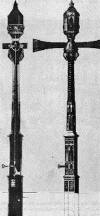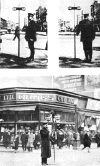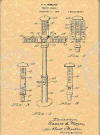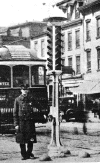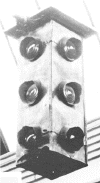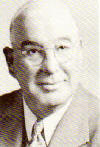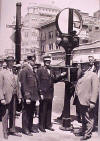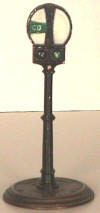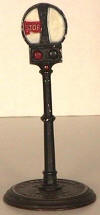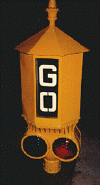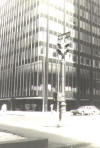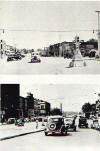|
|
Historical Signals |
|
![]()
Be sure to click on the linked photos for closer views!
As early as the mid-1800's, the railroads in both England and the United States were using lanterns, hung from crossbars, to give railroad men a signal visible by night as well as by day. For the control or direction of street traffic by colored lights however, England appears to have led the way. The worlds first traffic signal using colored lights was installed in December of 1868 at the intersection of George and Bridge Streets near the Houses of Parliament. It had been installed in response to a suggestion by a select committee that railway signal gear be adapted to street traffic. It's purpose was to give protection to members of Parliament and lesser street crossers at a point where vehicle traffic was very heavy.
The resulting signal was invented by J.P. Knight, a railroad signaling engineer. Shown here by a surviving drawing, it was to have been an imposing 22' high and crowned with a gas light. The semaphore arms, when extended horizontally, meant "Stop". When lowered to a droopy 45° angle, meant "Caution". At night, a green light and red light were used in conjunction with the arms.
Although it is entirely possible and probable that other attempts were made to control traffic by colored lights after this London experience, no recorded account has come down to us until the earlier part of the 20th century.
POLICE CONTROLLED DEVICES- The very first traffic "signals" in the United States were of the "railroad switch stand" type...that is they were rotated manually by a policeman 90 degrees to show the indication "STOP" or "GO". Cleveland, Ohio was the birthplace of the first traffic signal installation in the United States. The first signalized intersection was located at the intersection of 9th St. and Euclid St. around 1908. At night very often, a lantern was used at the top to show either red or green displays. This method was rather labor intensive because an officer had to be located at every busy intersection in which these were used! In the examples shown here, the top two photos on the left, show manipulating semaphores in Detroit. The lower photo is of a Vancouver, B.C. intersection sometime before WWII.
Garrett Morgan, an African-American inventor, is usually credited with a similar style of light, however, it wasn't until 1922 that he was awarded the patent for the device and the mechanism used to rotate the flags. He sold his rights later to General Electric for $40,000. The picture shown here is the original drawing by Garrett Morgan of his signal to obtain the patent.
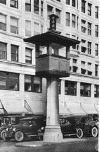 TRAFFIC TOWERS- The next phase in the evolution of the traffic
signal, was to employ the use of traffic towers. These came in a
variety of shapes and sizes, with, or without electric signals
mounted on them. This photo is of one with a signal atop built by
the Yellow Cab Co. of Chicago. The date is 1927.
TRAFFIC TOWERS- The next phase in the evolution of the traffic
signal, was to employ the use of traffic towers. These came in a
variety of shapes and sizes, with, or without electric signals
mounted on them. This photo is of one with a signal atop built by
the Yellow Cab Co. of Chicago. The date is 1927.
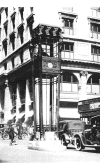 Here is another, more ornate example of a traffic tower. This one
was located on the busiest corner of that time in the US...Fifth
and 42nd St. in New York City. This tower was made out of bronze.
Here is another, more ornate example of a traffic tower. This one
was located on the busiest corner of that time in the US...Fifth
and 42nd St. in New York City. This tower was made out of bronze.
 Some of the first signals took on interesting designs. The photo
at left shows Los Angeles' early experiments with traffic
control. Here, they used large rectangular panels that displayed
red, yellow, and green. These signals were mounted on rather
large, concrete pedestals that were equipped with flashing lights
to fend off unsuspecting motorists. The center photo shows a
message-augmented two color signal in 1927 Rochester, NY. The
right photo shows another view of the early hand-operated
semaphore signal.
Some of the first signals took on interesting designs. The photo
at left shows Los Angeles' early experiments with traffic
control. Here, they used large rectangular panels that displayed
red, yellow, and green. These signals were mounted on rather
large, concrete pedestals that were equipped with flashing lights
to fend off unsuspecting motorists. The center photo shows a
message-augmented two color signal in 1927 Rochester, NY. The
right photo shows another view of the early hand-operated
semaphore signal.
Here's an interesting signal for you "multi-light" fans
out there! Count 'em...7 lights on each of it's four sides! This
signal built by the Novalux Electric Automatic Signal Company, a
subsidiary of the General Electric Company, was pleased to
introduce this "Safe and sane solution for the problems of
traffic regulation." The signal could be operated by hand,
and it was equipped with a hooded light at the top for protection
of the officer operating it.
 SALT LAKE CITY'S FIRST ELECTRIC SIGNAL
SALT LAKE CITY'S FIRST ELECTRIC SIGNAL
Lester Wire invented this version of the traffic signal in 1912.
It was installed on the corner of 2nd South St. and Main. It was
made of wood and metal with 8" "railroad type"
lenses and was manually controlled. Interestingly enough, when
this signal was retired in the early 20's, it was moved to
Liberty Park and used as a birdhouse! No one knows of it's
whereabouts today.
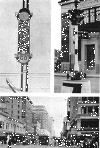 Here are three more versions of the traffic signal. A Seattle
intersection is shown in the bottom picture, with both a
conventional 3 color signal overhead and a traffic tower on the
right. The top right photo shows a pedestal mounted two color
signal with illumination at the top and warning flashers at it's
base. This signal showed up in Detroit around 1923. The top left
signal was called the "Attica Signal" built in 1924.It
was used in Harrisburg, PA and had ten small and two large
indications for traffic in both directions.
Here are three more versions of the traffic signal. A Seattle
intersection is shown in the bottom picture, with both a
conventional 3 color signal overhead and a traffic tower on the
right. The top right photo shows a pedestal mounted two color
signal with illumination at the top and warning flashers at it's
base. This signal showed up in Detroit around 1923. The top left
signal was called the "Attica Signal" built in 1924.It
was used in Harrisburg, PA and had ten small and two large
indications for traffic in both directions.
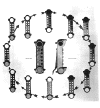 This drawing further illustrates the functionality of the Attica
Signal. It featured countdown lights showing motorists how much
time they had before the light change. Pedestrians only saw the
red and green lights as shown in the right center drawing. The
device also featured a cast aluminum case.
This drawing further illustrates the functionality of the Attica
Signal. It featured countdown lights showing motorists how much
time they had before the light change. Pedestrians only saw the
red and green lights as shown in the right center drawing. The
device also featured a cast aluminum case.
This photo shows a signal that was first installed in Long Beach. This "Banjo" signal has a disc at the top, in which an inner disc would rotate to reveal the messages along with a warning bell as the messages change. Lights would be employed at night.
Pictures of a model of this type of signal showing the legends and lamp colors. The bottom light was used at night for late night flash. This example also shows how ornate and fancy poles of the day were. Everything was made rather tastefully and aesthetically then.
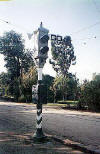 This
photo shows the Acme
"semaphore" signals that were
quite popular in Los Angeles
in the 20's and 30's. When the
signal would "change", a bell
would ring and the flags on
the side would exchange places
via a synchronous motor. Also
red and green lights were used
on the head itself with a
smaller light used for late
night flash. The flag change
took about 5 seconds.
Acme signals did not have a
yellow indication, as we know
it today. When the signal
changed, it would go red in
all directions, for a few
seconds. This would give
traffic that was approaching
the intersection a few seconds
to clear the intersection,
before the opposite street's
signal turned to green. After
dark, generally about 9:00
P.M., the arms would both fold
in to the case. After that
time, only the lights alone
would operate.
This
photo shows the Acme
"semaphore" signals that were
quite popular in Los Angeles
in the 20's and 30's. When the
signal would "change", a bell
would ring and the flags on
the side would exchange places
via a synchronous motor. Also
red and green lights were used
on the head itself with a
smaller light used for late
night flash. The flag change
took about 5 seconds.
Acme signals did not have a
yellow indication, as we know
it today. When the signal
changed, it would go red in
all directions, for a few
seconds. This would give
traffic that was approaching
the intersection a few seconds
to clear the intersection,
before the opposite street's
signal turned to green. After
dark, generally about 9:00
P.M., the arms would both fold
in to the case. After that
time, only the lights alone
would operate.
 Here
is a photo of one of the last
remaining "semaphore style"
traffic signals. It is located
in the Smithsonian Museum at
Washington D.C. There is
another interesting fact about
these signals. At about
midnight, or 1:00 A.M., the
signals stopped working. At
that time, the small flashers
at the bottom of the signal
came on. These small lights
flashed late at night, when
normal "STOP & GO" operation
was no longer necessary.
Typically, the yellow flashers
were for the primary street,
and the red flashers for the
secondary street. When two
major streets crossed, both
streets had red flashers. If a
street had yellow flashers,
the signal post was painted
yellow. If the street had red
flashers, the signal post was
painted with black and white
"zebra stripes" as pictured
above. (Additional information
provided by David Morgan)
Here
is a photo of one of the last
remaining "semaphore style"
traffic signals. It is located
in the Smithsonian Museum at
Washington D.C. There is
another interesting fact about
these signals. At about
midnight, or 1:00 A.M., the
signals stopped working. At
that time, the small flashers
at the bottom of the signal
came on. These small lights
flashed late at night, when
normal "STOP & GO" operation
was no longer necessary.
Typically, the yellow flashers
were for the primary street,
and the red flashers for the
secondary street. When two
major streets crossed, both
streets had red flashers. If a
street had yellow flashers,
the signal post was painted
yellow. If the street had red
flashers, the signal post was
painted with black and white
"zebra stripes" as pictured
above. (Additional information
provided by David Morgan)
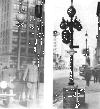
Another
version used in San Francisco
was the "Ghiglieri
Signal" named for its
inventor William Ghiglieri. It
featured flashing red and
green lights and earlier
versions used a bell to help acquaint
motorists and pedestrians
alike of it's presence. This
one was used on famed Market
Street.
 This
is the "Wiley Signal", and became overwhelmingly popular in San Francisco. In
fact, only recently did the last one of these parish into oblivion. Curiously
enough though, these never caught on outside of the city. It used a eight sided
cylindrical message in the top that would rotate between "STOP" and "GO" 45 degrees, and had a bell that sounded when it
changed. One can still be seen in the Cable Car Museum downtown,
and two are still used, although modified a bit, at Knott's Berry
Farm in Buena Park, Ca.
This
is the "Wiley Signal", and became overwhelmingly popular in San Francisco. In
fact, only recently did the last one of these parish into oblivion. Curiously
enough though, these never caught on outside of the city. It used a eight sided
cylindrical message in the top that would rotate between "STOP" and "GO" 45 degrees, and had a bell that sounded when it
changed. One can still be seen in the Cable Car Museum downtown,
and two are still used, although modified a bit, at Knott's Berry
Farm in Buena Park, Ca.
The color of the Wiley signal head was typically yellow with a green pole. Because the base is cast iron, this signal weighs close to 200 lbs!
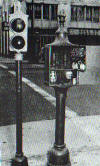
Here is another version of the signal. This
one was much smaller and was used in later years as a pedestrian
signal. It featured 6" colored
lenses that were embossed
"STOP" and "GO". Notice the
ornate controller cabinet next
to this signal. Signals
and cabinets during the 30's
and 40's featured "art deco"
manufacturing styles. Tasteful
and aesthetic!!
 This is the "Darley Signal" and was used a bit later
down the time line. Its claim to fame was that it only used two
lights, and that the lenses on the right angle movements were
swapped (i.e. green on top)! Because of this, it made use of
embossed letters on the lenses with "STOP" and
"GO" written on them. Other than the obvious, the other
drawback this signal had was that there were no provisions for a
reflector because of the design. This made it hard to be seen on
bright sunny days. This signal along with it's 3 light younger
brother were very popular in small town rural America.
Crouse-Hinds was the other manufacturer popular around this time,
and you can see a photo of this type in my "Signals"
section. (Photo by Pete Yauch)
This is the "Darley Signal" and was used a bit later
down the time line. Its claim to fame was that it only used two
lights, and that the lenses on the right angle movements were
swapped (i.e. green on top)! Because of this, it made use of
embossed letters on the lenses with "STOP" and
"GO" written on them. Other than the obvious, the other
drawback this signal had was that there were no provisions for a
reflector because of the design. This made it hard to be seen on
bright sunny days. This signal along with it's 3 light younger
brother were very popular in small town rural America.
Crouse-Hinds was the other manufacturer popular around this time,
and you can see a photo of this type in my "Signals"
section. (Photo by Pete Yauch)
 This is the "Darley Signal" and was used a bit later
down the time line. Its claim to fame was that it only used two
lights, and that the lenses on the right angle movements were
swapped (i.e. green on top)! Because of this, it made use of
embossed letters on the lenses with "STOP" and
"GO" written on them. Other than the obvious, the other
drawback this signal had was that there were no provisions for a
reflector because of the design. This made it hard to be seen on
bright sunny days. This signal along with it's 3 light younger
brother were very popular in small town rural America.
Crouse-Hinds was the other manufacturer popular around this time,
and you can see a photo of this type in my "Signals"
section. (Photo by Pete Yauch)
This is the "Darley Signal" and was used a bit later
down the time line. Its claim to fame was that it only used two
lights, and that the lenses on the right angle movements were
swapped (i.e. green on top)! Because of this, it made use of
embossed letters on the lenses with "STOP" and
"GO" written on them. Other than the obvious, the other
drawback this signal had was that there were no provisions for a
reflector because of the design. This made it hard to be seen on
bright sunny days. This signal along with it's 3 light younger
brother were very popular in small town rural America.
Crouse-Hinds was the other manufacturer popular around this time,
and you can see a photo of this type in my "Signals"
section. (Photo by Pete Yauch)
 Many
two lamp signals once reigned in New York City.
These were unique because of the unusual style of lamp sequence. From green the
sequence would show a brief "red/yellow" combination before going to red. The
green/red combo produced a "yellow" like light from a distance and this effect
was the pioneer to the separate yellow clearance lamp years later.
Most of these signals lasted well into the later part of the century. This
signal was located along Park Avenue. For more pictures of NYC's classic
signals, click either of the photos! (Photo courtesy of Kevin Walsh)
Many
two lamp signals once reigned in New York City.
These were unique because of the unusual style of lamp sequence. From green the
sequence would show a brief "red/yellow" combination before going to red. The
green/red combo produced a "yellow" like light from a distance and this effect
was the pioneer to the separate yellow clearance lamp years later.
Most of these signals lasted well into the later part of the century. This
signal was located along Park Avenue. For more pictures of NYC's classic
signals, click either of the photos! (Photo courtesy of Kevin Walsh)
Charles Adler Jr. is credited with the title
of "inventor" of the first actuated signals. The first
one in daily use was at the corner of Falls road and Belvedere
Avenue in Baltimore. The date was February 22, 1928. The picture
above shows Baltimore's famous Traffic Commissioner Henry Barnes
(left), inventor Charles Adler Jr. (center), and Assistant
Traffic Commissioner Charles Upham, Jr. placing a plaque
commemorating the site of the first actuated signal.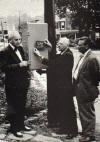
This west coast intersection shows the
invention in greater detail. Basically, a motorist would pull up
to the intersection and blow the horn. The sound would then
trigger the controller to advance to the clearance stage on the
main arterial and give the right of way to the minor street for a
set amount of time. Pretty ingenious for the time, but noisy!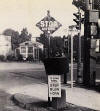
Charles also invented the first pedestrian
push button actuated device. Mrs. Adler is seen here pushing the
button to obtain the green light at the first one installed at
the intersection of Charles Street and Cold Spring Lane in
Baltimore. The date is February 4, 1929.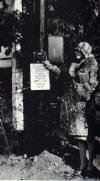
Remnants of the early days were still to be seen around the country until well after world War II. The "block buster" 4-way signal in the above photo is on U.S. 1 in South Carolina. The tower in the lower photo was shot in Baltimore at the Maryland-Charles Street intersection.
![]()
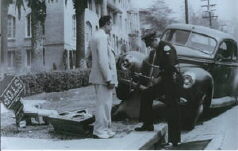
For a signalfan, this is a crime
for which there is no forgiveness!

Home
/
Bio
/
Signals
/
Misc.
/
Signs
/
Controllers
/
History
/
Links
/
Faq's
/
Club /
HO Layout
All contents ©1997-2016
by Signalfan. All rights reserved.
All text & photos may not be reproduced
without expressed written permission from webmaster.
All contents ©1997-2016 by Signalfan. All rights reserved.
All text & photos may not be reproduced without expressed written permission from webmaster.
